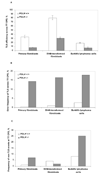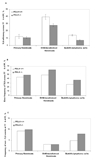Reduced efficiency and increased mutagenicity of translesion DNA synthesis across a TT cyclobutane pyrimidine dimer, but not a TT 6-4 photoproduct, in human cells lacking DNA polymerase eta
- PMID: 18634905
- PMCID: PMC2656611
- DOI: 10.1016/j.dnarep.2008.06.008
Reduced efficiency and increased mutagenicity of translesion DNA synthesis across a TT cyclobutane pyrimidine dimer, but not a TT 6-4 photoproduct, in human cells lacking DNA polymerase eta
Abstract
Xeroderma pigmentosum variant (XPV) patients carry germ-line mutations in DNA polymerase eta (poleta), a major translesion DNA synthesis (TLS) polymerase, and exhibit severe sunlight sensitivity and high predisposition to skin cancer. Using a quantitative TLS assay system based on gapped plasmids we analyzed TLS across a site-specific TT CPD (thymine-thymine cyclobutane pyrimidine dimer) or TT 6-4 PP (thymine-thymine 6-4 photoproduct) in three pairs of poleta-proficient and deficient human cells. TLS across the TT CPD lesion was reduced by 2.6-4.4-fold in cells lacking poleta, and exhibited a strong 6-17-fold increase in mutation frequency at the TT CPD. All targeted mutations (74%) in poleta-deficient cells were opposite the 3'T of the CPD, however, a significant fraction (23%) were semi-targeted to the nearest nucleotides flanking the CPD. Deletions and insertions were observed at a low frequency, which increased in the absence of poleta, consistent with the formation of double strand breaks due to defective TLS. TLS across TT 6-4 PP was about twofold lower than across CPD, and was marginally reduced in poleta-deficient cells. TLS across TT 6-4 PP was highly mutagenic (27-63%), with multiple mutations types, and no significant difference between cells with or without poleta. Approximately 50% of the mutations formed were semi-targeted, of which 84-93% were due to the insertion of an A opposite the template G 5' to the 6-4 PP. These results, which are consistent with the UV hyper-mutability of XPV cells, highlight the critical role of poleta in error-free TLS across CPD in human cells, and suggest a potential involvement, although minor, of poleta in TLS across 6-4 PP under some conditions.
Figures


References
-
- Friedberg EC, Walker GC, Siede W, Wood RD, Schultz RA, Ellenberger T. DNA Repair and Mutagenesis. Washington DC: ASM Press; 2006.
-
- Vreeswijk MP, van Hoffen A, Westland BE, Vrieling H, van Zeeland AA, Mullenders LH. Analysis of repair of cyclobutane pyrimidine dimers and pyrimidine 6-4 pyrimidone photoproducts in transcriptionally active and inactive genes in Chinese hamster cells. J. Biol. Chem. 1994;269:31858–31863. - PubMed
-
- Tung BS, McGregor WG, Wang YC, Maher VM, McCormick JJ. Comparison of the rate of excision of major UV photoproducts in the human HPRT gene of normal and xeroderma pigmentosum variant cells. Mutat. Res. 1996;362:65–74. - PubMed
-
- Nakajima S, Lan L, Kanno S, Takao M, Yamamoto K, Eker AP, Yasui A. UV light-induced DNA damage and tolerance for the survival of nucleotide excision repair-deficient human cells. J. Biol. Chem. 2004;279:46674–46677. - PubMed
-
- Johnson RE, Prakash S, Prakash L. Efficient bypass of a thymine-thymine dimer by yeast DNA polymerase Pol eta. Science. 1999;283:1001–1004. - PubMed
Publication types
MeSH terms
Substances
Grants and funding
LinkOut - more resources
Full Text Sources
Miscellaneous

